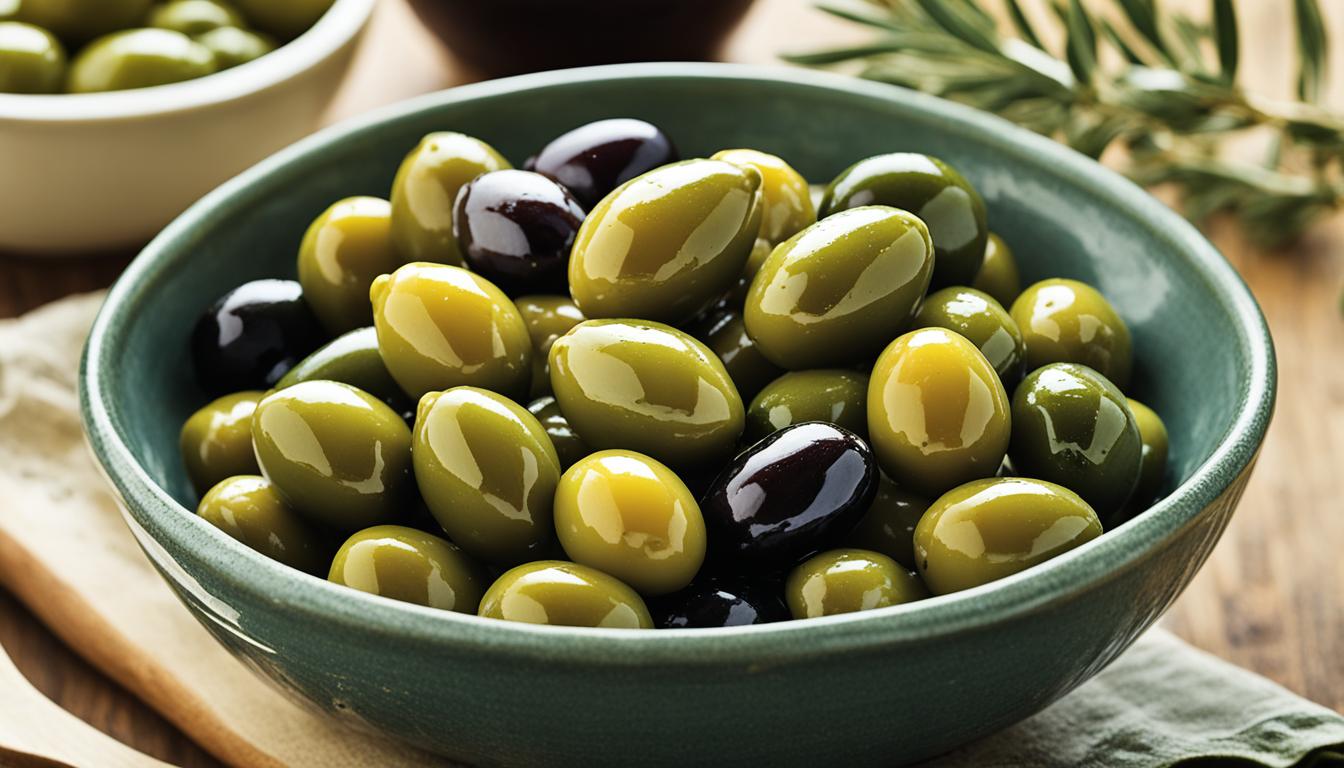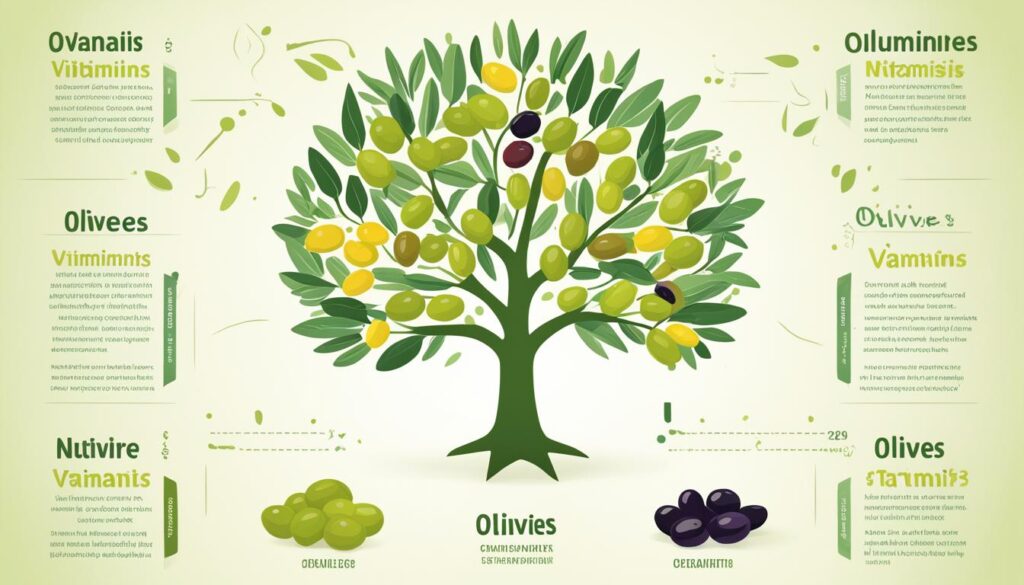Is Olive a Vegetable? Uncover the Truth Here

Are you curious about whether olives are classified as vegetables or fruits? The answer may surprise you. In this article, we will explore the different perspectives and classifications of olives, providing you with a clear understanding of their categorization. Let’s dive in!
Key Takeaways:
- Olives have different classifications, creating a debate over their categorization as vegetables or fruits.
- Botanical and culinary aspects play a role in determining the classification of olives.
- Olives are a rich source of essential nutrients, including calories, fats, fiber, and vitamins.
- Consuming olives may have various health benefits, such as antioxidant properties and reducing inflammation.
- Olives are versatile ingredients in both traditional and modern cuisine, adding unique flavors to dishes.
The Classification of Olives
When it comes to the classification of olives, there are various factors to consider in determining whether they are categorized as vegetables or fruits. Both botanical and culinary aspects contribute to the overall understanding of olives and their classification.
Botanically speaking, olives are classified as fruits. They grow on olive trees, which are members of the Oleaceae family. The olive fruit is classified as a drupe, which is a fruit with a fleshy outer layer, a pit, and an inner seed.
Culinarily, however, olives are often considered as vegetables due to their savory and flavorful characteristics. They are commonly used in cooking and food preparation, enhancing the taste profiles of various dishes.
To delve deeper into the classification of olives, let’s take a closer look at the different types of olives and their distinct characteristics. Here is a table highlighting some popular olive varieties:
| Varity | Taste | Origin |
|---|---|---|
| Kalamata | Salty and tangy | Greece |
| Green Manzanilla | Crisp and slightly bitter | Spain |
| Black Mission | Rich and fruity | United States |
These are just a few examples of the wide variety of olives, each with its own unique taste and origin. Exploring the different olive varieties can be a fascinating journey into the diverse world of flavors and culinary traditions.
To summarize, while botanically olives are classified as fruits, they are often considered as vegetables in the culinary world. Their classification can vary depending on the context and perspective. In the upcoming sections, we will further explore the nutritional content, health benefits, and culinary versatility of olives, shedding light on their remarkable qualities.
Nutritional Content of Olives
When it comes to the nutritional content of olives, they are packed with a range of essential nutrients that offer numerous health benefits. Let’s explore the rich composition of these versatile fruits:
Fiber
Olives are a good source of dietary fiber, which plays a crucial role in maintaining a healthy digestive system. A serving of olives provides approximately [insert specific amount] grams of fiber, aiding in digestion and promoting feelings of fullness.
Healthy Fats
Despite their small size, olives are known for their high fat content. However, the fats found in olives are primarily monounsaturated fats, which are considered heart-healthy. These fats can help reduce LDL cholesterol levels and lower the risk of heart disease.
Antioxidants
The antioxidant properties of olives are significant contributors to their health benefits. These antioxidants, such as vitamin E and polyphenols, help protect the body against oxidative stress and inflammation, reducing the risk of chronic diseases.
Vitamins and Minerals
Olives are a good source of various vitamins and minerals. They contain vitamin A, vitamin E, calcium, iron, and copper, among others, all of which are essential for maintaining optimal health.
| Nutrient | Amount per Serving |
|---|---|
| Calories | [insert specific amount] |
| Total Fat | [insert specific amount] grams |
| Fiber | [insert specific amount] grams |
| Vitamin E | [insert specific amount] milligrams |
| Calcium | [insert specific amount] milligrams |
| Iron | [insert specific amount] milligrams |
| Copper | [insert specific amount] milligrams |
As you can see, olives are not only delicious but also provide a wide array of nutrients that contribute to overall well-being. Including olives in your diet can be a delicious way to add nutritional value to your meals.

Health Benefits of Olives
Olives are not only delicious but also offer a wide range of health benefits. Incorporating olives into your diet can contribute to your overall well-being in several ways. Let’s explore some of the key health benefits associated with consuming olives.
1. Antioxidant Powerhouse
Olives are packed with antioxidants that help protect your body against free radicals. These compounds neutralize harmful molecules that can damage cells and lead to chronic diseases. The high concentration of antioxidants in olives makes them a powerful addition to your diet.
2. Heart Health Promotion
The health benefits of olives extend to cardiovascular health. Olives are a good source of monounsaturated fats, which can help reduce cholesterol levels and lower the risk of heart disease. Additionally, the presence of oleic acid in olives has been linked to improved heart health.
3. Anti-Inflammatory Properties
Consuming olives may have anti-inflammatory effects on the body. Olives contain compounds that can help reduce inflammation, which is associated with various chronic conditions, including arthritis, heart disease, and certain types of cancer.
4. Promotes Digestive Health
The high fiber content in olives supports digestive health by promoting regular bowel movements and preventing constipation. Additionally, olives aid in the development of healthy gut bacteria, which can have a positive impact on overall digestion and nutrient absorption.
5. Source of Essential Nutrients
In addition to their outstanding taste, olives are a rich source of essential nutrients. They are particularly high in vitamin E, iron, and copper, which play important roles in maintaining optimal health and supporting various bodily functions.
“Incorporating olives into your diet can offer a multitude of health benefits, from promoting heart health to reducing inflammation.” – Dr. Amanda Anderson, Nutrition Expert
With their diverse range of health benefits, olives are a valuable addition to any well-rounded diet. By incorporating olives into your meals, you can not only enhance the flavors but also improve your overall well-being.
Culinary Versatility of Olives: From Traditional to Modern
When it comes to cooking with olives, the possibilities are endless. These small fruits pack a punch of flavor that can elevate any dish, from traditional Mediterranean recipes to modern culinary creations. Whether you’re a fan of their briny bite or crave their buttery texture, olives have a special place in cuisine around the world.
One of the most popular ways to incorporate olives into your cooking is by adding them to salads. The salty and tangy notes of olives can provide a delightful contrast to fresh greens, making every bite a burst of flavor. Try tossing together a classic Greek salad with ripe tomatoes, cucumbers, feta cheese, and a generous handful of Kalamata olives for a true taste of the Mediterranean.
If you’re looking to elevate your pasta dishes, olives can be a game-changer. Add a handful of sliced black olives to your next spaghetti carbonara for an extra layer of complexity. Their umami flavors will complement the creamy sauce and bacon, creating a harmonious balance of tastes that will leave you craving more.
For those who love the combination of sweet and savory, olives can be incorporated into unexpected dishes like fruit salsas. Try pairing finely chopped green olives with diced mangoes, red onions, jalapenos, and fresh cilantro for a unique and vibrant salsa that will take your taste buds on a flavor adventure.
“Cooking with olives allows you to explore a wide range of flavors and textures. Their versatility knows no bounds, with the ability to enhance both traditional and modern dishes.”
In addition to their versatility in cooking, olives also make a delicious snack on their own. Enjoy them straight out of the jar or pair them with a selection of cured meats and cheese for an effortless charcuterie board that will impress your guests.
To inspire your culinary adventures, here are a few olive-inspired recipes to try:
1. Olive Tapenade Crostini
Spread a luscious olive tapenade on toasted baguette slices and top with a sprinkle of freshly grated Parmesan cheese for a simple yet elegant appetizer.
2. Mediterranean Olive Chicken
Simmer chicken breasts in a tangy olive and tomato sauce seasoned with Mediterranean spices such as oregano, thyme, and garlic for a hearty and flavorful main course.
3. Olive-Stuffed Mushroom Caps
Stuff large mushroom caps with a savory mixture of chopped olives, breadcrumbs, and herbs, then bake until golden and tender for an irresistible vegetarian option.

As you explore the culinary versatility of olives, don’t be afraid to experiment and let your taste buds guide you. Whether you’re adding them to classics or inventing new recipes, olives in cuisine can transform ordinary dishes into extraordinary culinary experiences.
Olives in the Mediterranean Diet
The Mediterranean diet is renowned for its emphasis on fresh, nutritious ingredients that promote overall health and wellbeing. Amongst these ingredients, olives play a starring role, adding a burst of flavor and numerous health benefits to the diet.
Rich in heart-healthy monounsaturated fats, olives are a staple in Mediterranean cuisine, enhancing a wide range of dishes with their distinctive taste. Whether used as a topping for salads, incorporated into hearty stews, or enjoyed as a standalone snack, olives bring a unique flavor profile to any meal.
Olives are not only delicious but also provide a variety of health benefits. They are a great source of vitamin E, which acts as a powerful antioxidant, protecting the body against cellular damage. Additionally, olives contain polyphenols, which have been associated with reduced inflammation and improved heart health.
In the Mediterranean diet, olives are often used in combination with other nutritious ingredients such as olive oil, fresh vegetables, whole grains, and lean proteins. This creates a balanced and flavorful eating plan that promotes long-term health and wellness.
Sample Olive Recipe
Here’s a simple and delicious olive recipe to try:
Greek Salad with Olives
Ingredients:
- 2 cups mixed salad greens
- 1 cup cherry tomatoes, halved
- 1 cucumber, sliced
- 1/4 red onion, thinly sliced
- 1/2 cup Kalamata olives, pitted
- 1/4 cup feta cheese, crumbled
- 2 tablespoons extra virgin olive oil
- 1 tablespoon lemon juice
- Salt and pepper to taste
Instructions:
- In a large bowl, combine the salad greens, cherry tomatoes, cucumber, red onion, and Kalamata olives.
- In a small bowl, whisk together the olive oil, lemon juice, salt, and pepper.
- Drizzle the dressing over the salad and toss gently to combine.
- Sprinkle the crumbled feta cheese on top and serve.
Exploring Olive Varieties and Tasting Notes
When it comes to olives, there is an incredible variety to choose from, each with its unique flavors and tasting notes. From robust and fruity to delicate and buttery, exploring different olive varieties can be a delightful journey for your taste buds.
Let’s dive into some of the most popular olive varieties and uncover their distinct characteristics:
| Olive Variety | Tasting Notes |
|---|---|
| Kalamata Olives | A rich and tangy flavor with hints of red wine and a slightly sweet finish. These olives are often used in Greek cuisine, particularly in salads and meze platters. |
| Spanish Manzanilla Olives | These olives have a firm texture and a briny, slightly salty taste. They are commonly stuffed with pimento or anchovies and are popular in cocktails like martinis. |
| Nicoise Olives | Originally from France, these olives are small, dark, and have a fruity flavor with a hint of bitterness. They are a key ingredient in the famous Niçoise salad. |
| Queen Olives | A large and meaty olive variety, often stuffed with garlic, almonds, or peppers. They have a mildly salty taste and are perfect for snacking or adding to charcuterie boards. |
In addition to the ones mentioned above, other popular olive varieties include Picholine, Cerignola, and Ligurian olives. Each variety brings its own unique qualities to dishes and culinary creations.
To enhance your olive tasting experience, try pairing different olive varieties with complementary ingredients. For example, pairing Kalamata olives with feta cheese and fresh herbs can result in an explosion of Mediterranean flavors, while Nicoise olives can beautifully complement grilled tuna and green beans in a classic Niçoise salad.
Explore the diverse world of olives and let your taste buds be your guide. Whether you prefer the robust intensity of Kalamata olives or the subtle elegance of Queen olives, experimenting with different varieties will add depth and sophistication to your culinary adventures.
Conclusion
After thorough exploration, we have answered the intriguing question of whether olives are classified as vegetables or fruits. While olives are commonly regarded as a fruit due to their botanical classification, their culinary usage and preparation align them with the category of vegetables in various contexts.
Throughout our journey, we have uncovered the nutritional content and health benefits of olives. These small powerhouses are packed with essential nutrients, making them a valuable addition to any diet. Their potential antioxidant properties, role in heart health, and ability to reduce inflammation highlight their positive impact on overall well-being.
Not only are olives nutritionally beneficial, but they also offer culinary versatility. From traditional Mediterranean recipes to modern and innovative dishes, olives enhance flavors and add depth to various cuisines. Their distinct and nuanced tasting notes, ranging from robust and fruity to delicate and buttery, provide a delightful exploration of flavors.
Furthermore, olives have a significant presence in the esteemed Mediterranean diet. As an integral ingredient in this renowned eating plan, olives contribute to a balanced and flavorful approach to nutrition. By incorporating olives into your meals, you can embrace the wholesome essence of this time-honored culinary tradition.
In summary, whether you consider olives a vegetable or a fruit, their undeniable benefits and unique flavors make them a delightful addition to any diet. Embrace the goodness of olives in your culinary adventures, savoring their distinct taste profiles and reaping the rewards of their nutritional value.







